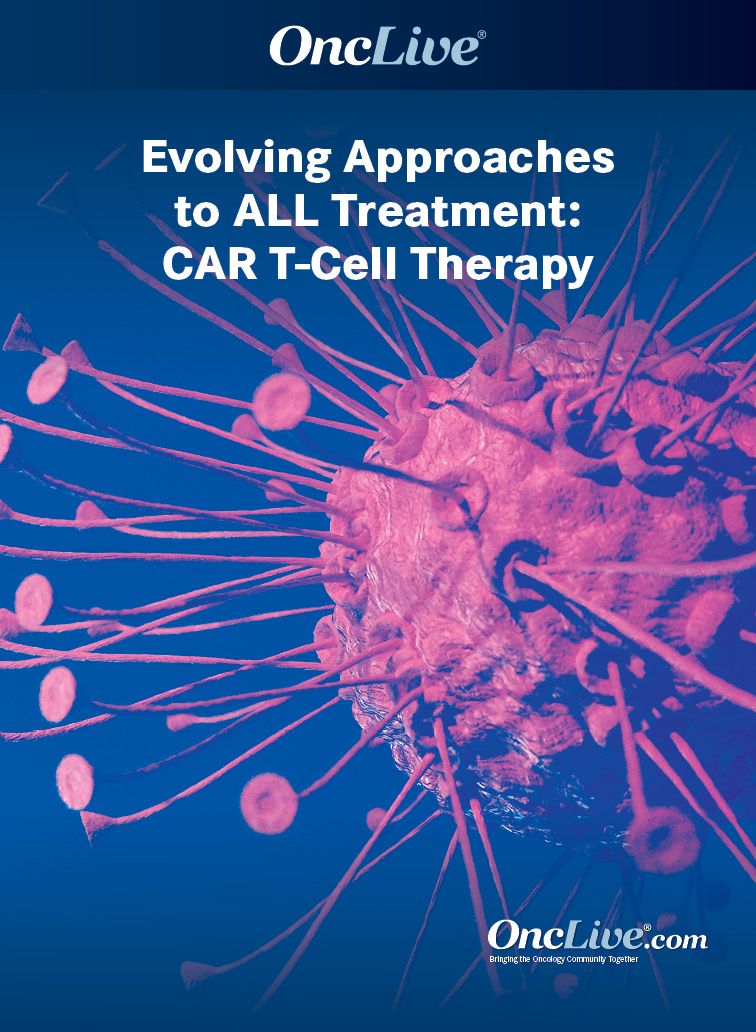Obe-cel May Prove a Tolerable Treatment Alternative in Relapsed/Refractory B-ALL
Sameem Abedin, MD, discusses where CAR T-cell therapy falls in the treatment paradigm for B-cell acute lymphoblastic leukemia, the known safety profile of obe-cel as evidenced in early studies, and how findings from the FELIX trial could change the future management of this disease.
Sameem Abedin, MD

The unique mechanism of action and favorable safety profile of obecabtagene autoleucel (obe-cel) could improve outcomes in patients with B-cell acute lymphoblastic leukemia (B-ALL) and pave the way for future advances with CAR T-cell therapy in this population, according to Sameem Abedin, MD.
“[There] are potential differences that obe-cel can offer that may push forward how CAR T-cell therapy can help patients,” Abedin said in an interview with OncLive®.
The single-arm, multicenter, phase 1/2 FELIX trial (NCT04404660) is investigating the safety and efficacy of obe-cel in adult patients with relapsed/refractory B-ALL. The primary end point of the phase 1b part is the frequency and severity of adverse effects (AEs), and the primary end point of the phase 2 part is overall response rate. Secondary end points in the phase 2 part include minimal residual disease (MRD) negativity, complete response (CR) rate, duration of response (DOR), progression-free survival, and overall survival (OS).1
Currently, brexucabtagene autoleucel (brexu-cel; Tecartus) is the only CAR T-cell therapy approved in [adult] B-ALL. The approval was based on findings from the single-arm, phase 2 ZUMA-3 trial (NCT02614066), in which 71% (95% CI, 57%-82%) of patients with relapsed/refractory B-ALL who received the agent achieved a CR or CR with incomplete hematologic recovery, and 56% of patients achieved CR. The median DOR in these patients was 12.8 months (95% CI, 8.7-not estimable).2
In the interview, Abedin discussed where CAR T-cell therapy falls in the treatment paradigm for B-ALL, the known safety profile of obe-cel as evidenced in early studies, and how findings from the FELIX trial could change the future management of this disease.
Abedin is an assistant professor of medicine in the Division of Hematology and Oncology at the Medical College of Wisconsin in Milwaukee.
OncLive: How have CAR T-cell therapies affected the B-ALL treatment paradigm?
Abedin: There have been several new treatments for relapsed/refractory B-ALL over the past several years. CAR T-cell therapy is exciting [because] the previous treatments that were available, blinatumomab [Blincyto] and inotuzumab ozogamicin [Besponsa], where we sought initial efficacy, had limitations [regarding] durability of response. With both novel agents, what we’ve seen in the real world and in trials were responses in about 60% of patients.
However, in the trials [with blinatumomab and inotuzumab ozogamicin, there was also] a limited DOR [with each agent, of 7.3 months and 4.6 months, respectively]. [We need] agents for patients with relapsed/refractory B-ALL that could potentially prolong DOR and survival in this otherwise serious condition.
The introduction of CAR T-cell therapy into B-ALL for adults was the approval of brexu-cel. Similar to other agents, brexu-cel has a favorable initial response rate. In the ZUMA-3 trial, there was a [CR] rate of 71%. The DOR [was also encouraging]. [Of the] patients who were enrolled on that trial for about 1 year, most [were relapse free]. OS was reported at around 2 years. That’s where CAR T-cell therapy has a role. [Compared with] other agents, [CAR T-cell therapy] offers the potential for prolonged DOR in this otherwise challenging situation.
What differentiates obe-cel, another CAR T-cell therapy under investigation in patients with B-ALL, from other agents in this setting?
Investigation into CAR T-cell therapy for patients with B-ALL is still a ripe field. Obe-cel is currently under investigation and has 2 differences compared with what we traditionally offer our patients with B-ALL. Compared with brexu-cel, obe-cel has a novel, low-affinity binding. This agent has a more natural binding to its target. This may result in lower rates of cytokine release syndrome [CRS] or immune effector cell–associated neurotoxicity syndrome [ICANS] after CAR T-cell therapy.
[Regarding] brexu-cel, for reference, in ZUMA-3, grade 3/4 CRS was reported in 24% of patients, and a similar rate of severe ICANS [was reported] as well. An early study with obe-cel showed no grade 3/4 CRS and low rates of ICANS in a handful of patients, who were also responsive to steroid therapy. That’s the first advantage [of obe-cel]. The adult population, certainly in relapsed disease, may also include several older patients, so having a more favorable safety profile is beneficial for this population.
The second difference from the currently available agent [is that] brexu-cel [has led to an efficacy] persistence of 5 or 6 months. With obe-cel, the costimulatory molecule that is being used in lymphoma, CD28, has been associated with increased persistence. The hope with obe-cel is that, in B-ALL, there will also be increased persistence of this CAR T-cell product. Hopefully, that translates to improved DOR with [obe-cel]. That is still under investigation.
The FELIX trial will continue to investigate obe-cel in B-ALL. What patient populations are being observed here?
The main enrollment [criteria for this trial] are patients with B-ALL that is relapsed/refractory after 1 line of therapy. Patients may or may not have received prior blinatumomab or inotuzumab ozogamicin. These are agents that are available for relapsed ALL. This trial may yield patients who are a bit [less pretreated] compared with patients who were enrolled in ZUMA-3.
A separate subcohort of patients who were MRD positive enrolled into the FELIX trial as well; this is an exploratory end point cohort. The reasoning behind that is perhaps these immune therapies could provide greater benefit when disease is at a lower burden and potentially even result in a longer DOR when given at that earlier time point. The main results will be reported on the patients with relapsed/refractory B-ALL, and hopefully those results will be available soon.
What are the goals of the FELIX trial?
I anticipate the response rates will be comparable to the responses we saw with [brexu-cel in] ZUMA-3. ZUMA-3 showed exceptional responses in about 70% of patients with highly refractory disease [who had progressed on several] lines of therapy. Hopefully, [the results from FELIX] will be in line with that.
However, the safety profile is what we’re mostly interested in with this trial. [We want to] see what the rates of severe or grade 3/4 CRS will be in patients enrolled in this trial. [We also want to] see the rates of ICANS. Where [obe-cel] may [provide the most] benefit is in the elderly population, where some [AEs] may be harder to [tolerate]. That’s the first end point that will differentiate [obe-cel from] what’s available right now.
Hopefully, [we will also see] durability [with obe-cel]. We hope to get some data and updates about persistence with this product. With brexu-cel, persistence was seen in the range of about 6 months. It would be interesting to see some preliminary evidence of persistence with [obe-cel] as well.
Lastly, [we want] to see if [treatment with obe-cel] translates [to OS improvement]. If it’s a safer product, persists longer, and offers an increased DOR, hopefully that means an improved OS. These are all the points we’ll watch as the results come out.
What is the importance of referring patients with B-ALL to clinical trials investigating CAR T-cell therapies?
While there are available novel agents for relapsed/refractory ALL, these agents don’t solve [the] problem. Some of these patients can be salvaged with allogeneic transplant upon remission. However, for most patients, CAR T-cell therapy [may] offer the most sustained survival [benefit] in the relapsed/refractory setting. Investigating these products offers the best chance for the broadest number of patients to potentially receive treatments that can give them a meaningful response and meaningful survival, as opposed to survival that we currently measure in months.
What other agents under investigation in B-ALL may further influence the treatment landscape?
In acute myeloid leukemia [AML], there’s been a renaissance with the introduction of venetoclax [Venclexta], and there is early evidence that venetoclax, and potentially the combination of venetoclax and navitoclax [ABT-263], may have a role in B-ALL and in ALL in general. We’re familiar with giving these agents to patients with AML, so I’m looking forward to seeing where they can potentially fit into the treatment algorithm for patients with B-ALL.
Regarding CAR T-cell therapy, what we’ve mentioned so far are single-targeting CAR T-cell products that target CD19. New CAR T-cell therapies are under investigation that dually target CD19 and CD20. We are excited to see whether this dual-targeting approach can either improve response [rates] or durability of responses. That’s another exciting treatment on the horizon. Those are the big ones that have the closest potential to change how we manage [B-ALL] right now.
What is your main message for colleagues regarding the development of obe-cel in the FELIX trial?
We are getting our taste of CAR T-cell therapy in the management of B-ALL. We’ve watched our partners that treat [patients with] lymphoma [provide] responses that are unexpected and durable in patients who were otherwise fated to do poorly. I’m hopeful that through this trial, we can move [obe-cel] forward and offer a product that’s broadly available and that we can consider in our whole range of patients in the clinic. That [will depend on] some sort of improved safety.
Additionally, [we need] products that are definitive. Right now, in patients who achieve a remission after CAR T-cell therapy, there is a question of whether allogeneic transplant is an appropriate consolidation. This concern is coming up because of the known limitations of the currently approved CAR T product, [which does not have long] persistence. Hopefully, [with obe-cel], we can get a product with definitive DOR and persistence that offers patients an end to their treatment journey.
References
- A study of CD19 targeted CAR T cell therapy in adult patients with relapsed or refractory B cell acute lymphoblastic leukemia (ALL). ClinicalTrials.gov. Updated August 31, 2022. Accessed March 24, 2023. https://www.clinicaltrials.gov/ct2/show/NCT04404660
- Shah BD, Ghobadi A, Oluwole OO, et al. KTE-X19 for relapsed or refractory adult B-cell acute lymphoblastic leukaemia: phase 2 results of the single-arm, open-label, multicentre ZUMA-3 study. Lancet. 2021;398(10299):491-502. doi:10.1016/S0140-6736(21)01222-8




